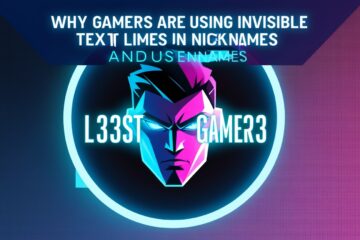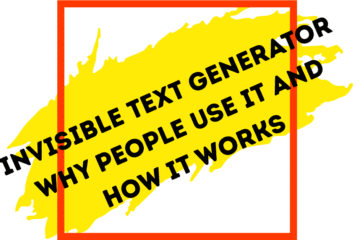Invisible text, also known as hidden text, refers to characters or elements that are not visible to the human eye but still exist within a digital platform’s structure. These characters play important roles in web development, SEO, digital design, content formatting, accessibility, and even social media and gaming. In this complete beginner’s guide, we’ll explore what invisible text is, how it works, why it matters, and how you can use it responsibly and creatively.
What Is Invisible Text?
Invisible text refers to any text or character that is not visible on-screen but still exists within the HTML code or data structure of a document. This text can be generated using zero-width characters, CSS styling, Unicode manipulation, or font color and background matching.
From the casual user creating blank Instagram bios to web developers writing hidden notes in code, invisible text has many uses. To create invisible text easily, you can use our free invisible text generator, which is built to simplify this process without requiring coding knowledge.
How Does Invisible Text Work?
There are several techniques to generate or implement invisible text:
1. Zero-Width Characters
Zero-width characters are Unicode characters that occupy no space and are not rendered visibly by browsers or display screens. Common examples include:
- Zero Width Space (ZWSP): U+200B
- Zero Width Joiner (ZWJ): U+200D
- Zero Width Non-Joiner (ZWNJ): U+200C
These characters can be inserted into usernames, messages, or text to create spacing or invisible effects.
2. Matching Text and Background Color
By setting the font color the same as the background (e.g., white text on a white background), the text becomes invisible to the naked eye. This technique was once used in black-hat SEO but is discouraged today.
3. CSS Display and Visibility Properties
Developers use CSS to hide elements:
display: none;– Completely removes the element from the layout.visibility: hidden;– Hides the element but keeps its space in the layout.opacity: 0;– Makes the element fully transparent.
Applications of Invisible Text
Invisible text has diverse and legitimate applications across multiple industries.
1. Web Development and Accessibility
Developers often use hidden text to improve user accessibility by including screen reader-only content. This ensures that visually impaired users can access critical information.
For example, the WebAIM guidelines promote the use of visually hidden text for:
- Navigational aids
- Descriptions of visual elements
- Hidden instructions or ARIA labels
2. Content Formatting
Invisible characters help in fine-tuning formatting in documents or websites:
- Controlling line breaks
- Adding spacing between elements
- Preventing auto-formatting
3. Social Media Aesthetics
Platforms like Instagram, TikTok, Twitter, and Facebook have character limits and strict formatting. Users often use invisible text to:
- Create blank bios
- Add line breaks
- Generate aesthetic spacing
- Post blank comments to stand out
You can create invisible text instantly for these purposes using our Invisible Text Generator.
4. Gaming and Unique Usernames
In multiplayer games like PUBG, Free Fire, and Fortnite, players use invisible text to:
- Create anonymous or mysterious usernames
- Join clans with no visible names
- Avoid copying or impersonation
This type of invisible name is created using zero-width characters. Try our tool to make yours.
5. Digital Design and Prototyping
Designers use invisible characters for layout control when prototyping websites or mobile apps. This includes:
- Adding placeholder space
- Preventing UI distortion
- Maintaining fixed line heights or padding
Is Invisible Text Safe and Legal to Use?
Yes – But It Depends on How You Use It
Invisible text itself is not illegal or harmful. However, misuse can lead to ethical or even legal concerns.
Ethical and Acceptable Uses:
- Screen-reader content for accessibility
- Invisible characters for formatting
- Social media aesthetic usage
- Privacy-friendly gaming usernames
Misuse Examples:
- Black-hat SEO: Hiding keyword-rich content to deceive search engines. Google penalizes this behavior as per their Spam Policies.
- Deception: Using invisible messages to trick or mislead users.
- Phishing and Malware: Hiding malicious links within invisible anchor tags (strictly prohibited).
If you’re using invisible text for legitimate purposes, especially for accessibility or customization, you’re on the right track.
SEO and Invisible Text: What You Need to Know
Invisible text is a controversial topic in SEO. Here’s how it can impact your rankings:
1. Penalties for Keyword Stuffing
Using hidden text to stuff keywords is outdated and can get your site penalized. Search engines like Google now prioritize user experience, readability, and helpful content.
2. Accessibility Boosts SEO
Using invisible text for screen readers improves your site’s accessibility, which contributes positively to SEO. According to Moz, user accessibility and page usability are indirect ranking factors.
3. Don’t Trick Google
Avoid hiding excessive text in headers, footers, or pages. Google’s crawlers are highly advanced and can detect deceptive hidden content.
Pro Tip:
If you want to enhance your website’s SEO ethically, focus on optimizing metadata, improving internal linking, and ensuring mobile responsiveness rather than using invisible text improperly.
How to Generate Invisible Text Easily
You don’t need to learn coding or Unicode to create invisible text. Use our simple Invisible Text Generator to:
- Copy and paste invisible characters
- Create blank bios or posts
- Insert zero-width spaces between letters
- Generate invisible names for gaming
Our tool is browser-based, free, and secure. You can even use it on mobile devices.
Examples of Invisible Text in Action
Example 1: Blank Instagram Bio
Paste the generated invisible text into your Instagram bio to make it appear blank.
Example 2: Invisible Username in PUBG
Create a blank or invisible clan name or nickname by pasting invisible characters.
Example 3: Line Break Control in Blogs
Use invisible characters to add precise spacing between paragraphs without affecting formatting.
Frequently Asked Questions
Q1: Can invisible text get me banned on Instagram?
A: No, using invisible characters for aesthetic purposes is allowed. However, spamming or deceptive use may violate their terms.
Q2: Will Google penalize my site for invisible text?
A: Only if it’s used to manipulate rankings. Invisible accessibility content is considered good SEO.
Q3: Can I use invisible text in email campaigns?
A: Yes, but ensure it’s not flagged as spam. Avoid overuse.
Q4: How do I remove invisible characters?
A: Use a text editor with a character cleaner or paste into Notepad to strip formatting.
Final Thoughts
Invisible text is a fascinating and multi-functional digital tool. From enhancing accessibility and formatting content to creating mysterious usernames, its applications are vast. However, it’s essential to use invisible text responsibly and ethically.
Whether you’re a designer, gamer, social media influencer, or accessibility advocate, tools like Invisible Text Generator make it easy to generate and use hidden characters effectively.
Ready to explore invisible text for your next project?
Visit our Homepage and try the tool today.
For support, feedback, or suggestions, feel free to Contact Us.



